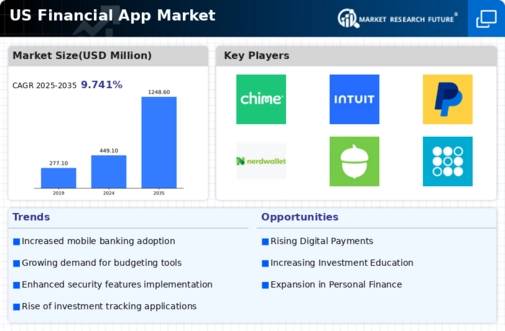Growing Demand for Investment Apps
The financial app market is witnessing a growing demand for investment applications, particularly among younger demographics. Recent data indicates that around 40% of millennials in the US actively use investment apps to manage their portfolios. This trend is fueled by the increasing interest in personal finance and wealth management, as individuals seek to take control of their financial futures. Investment apps often provide educational resources, making it easier for novice investors to navigate the complexities of the stock market. The financial app market is responding to this demand by offering innovative features such as robo-advisors and automated trading options. As more individuals recognize the importance of investing, the financial app market is likely to expand, attracting a diverse user base and fostering a culture of financial literacy.
Increased Adoption of Mobile Banking
The financial app market is experiencing a notable surge in mobile banking adoption, driven by the convenience and accessibility of financial services via smartphones. As of 2025, approximately 75% of adults in the US utilize mobile banking applications, reflecting a shift in consumer behavior towards digital solutions. This trend is likely to continue, as users increasingly prefer managing their finances on-the-go. The financial app market is benefiting from this transition, as banks and fintech companies invest in developing user-friendly applications that cater to the needs of tech-savvy consumers. Furthermore, the integration of features such as instant fund transfers and real-time transaction notifications enhances user engagement, potentially leading to increased customer loyalty and retention. As mobile banking becomes more entrenched in daily financial activities, the financial app market is poised for sustained growth.
Technological Advancements in Fintech
The financial app market is being propelled by rapid technological advancements within the fintech sector. Innovations such as blockchain technology, biometric authentication, and advanced data analytics are transforming how financial services are delivered. As of 2025, it is estimated that over 50% of financial apps in the US incorporate some form of advanced technology to enhance user experience and security. The financial app market is leveraging these technologies to streamline processes, reduce costs, and improve customer satisfaction. For instance, blockchain can facilitate faster and more secure transactions, while biometric authentication enhances security measures. As technology continues to evolve, the financial app market is likely to see increased competition, with companies striving to differentiate themselves through innovative solutions.
Regulatory Changes and Compliance Needs
The financial app market is significantly influenced by evolving regulatory frameworks and compliance requirements. In recent years, regulatory bodies in the US have implemented stricter guidelines to ensure consumer protection and data security. As a result, financial app developers are compelled to invest in compliance measures, which can be both a challenge and an opportunity. The financial app market must adapt to these changes by enhancing security protocols and ensuring transparency in transactions. This focus on compliance not only helps in building consumer trust but also positions companies favorably in a competitive landscape. As regulations continue to evolve, the financial app market may see increased collaboration between fintech firms and regulatory agencies, fostering innovation while maintaining compliance.
Rise of Subscription-Based Financial Services
The financial app market is experiencing a shift towards subscription-based financial services, which offer users premium features for a monthly or annual fee. This model is gaining traction as consumers seek personalized financial solutions that cater to their specific needs. Approximately 30% of users in the US are willing to pay for enhanced features such as advanced analytics, personalized financial advice, and ad-free experiences. The financial app market is adapting to this trend by developing tiered subscription plans that provide varying levels of service. This approach not only generates recurring revenue for app developers but also encourages user engagement and retention. As the demand for tailored financial solutions grows, the subscription model may become a dominant force within the financial app market.

















Leave a Comment